The iconic Statue of Liberty was a gift from France to the United States which was installed in New York Harbor almost one hundred and thirty years ago. The Statue of Liberty has become a constant symbol of the American freedom and liberties offered to the many immigrants traveling by steerage passage from the far off shores of Europe to the promising land of a new world throughout the past centuries. Over the last twenty years I have been researching my family’s genealogy and I can only imagine what a welcoming site it was when my maternal grandparents from Poland and my paternal grandparents from Italy accompanied by my father (as a young boy) arrived in the United States at nearby Ellis Island in the early 1900s. Many years later, on their honeymoon in New York City, my parents climbed to the top of the Statue of Liberty’s torch and looked out at the great city far below.
In this Travel post, I will discuss the construction and the history of the Statue of Liberty which took place in France and the construction of the pedestal which would be located on Liberty Island in New York Harbor in the United States. I will also discuss the history of the Statue of Liberty throughout the years. So, let’s get started …
A brief history of the Statue of Liberty
Inspiration and design of the Statue of Liberty –
There are several theories as to when and where the idea for the Statue of Liberty was first proposed but all involve Edouard Rene de Laboulaye who was a French poet, author and anti-slavery activist during the time of the American Civil War. After the war ended, Laboulaye became the president of the French Emancipation Committee which aided the newly freed slave in the United States. He is credited for coming up with the idea of creating a monument to be a gift from the French people to the United States to show their support of the recent victory by the Union. Laboulaye also felt that the monument would bring attention to the French fight for democracy under the repressive monarchy of Napoleon III. At some point, Laboulaye collaborated with his friend Frederic Auguste Batholdi who was an accomplished sculptor but it would be several more years until the idea became a reality.
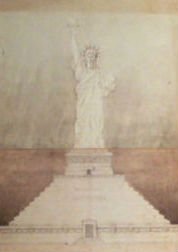
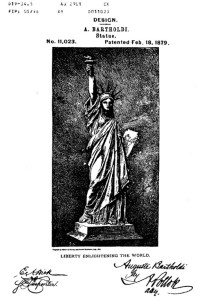
When Laboulaye and Bartholdi felt the time was right to proceed with the idea, Bartholdi went to the United States to meet directly with President Ulysses Grant to offer a proposal for the monument. He also traveled throughout the country meeting with other prominent and influential men to discuss the idea and gain support. As Bartholdi arrived in New York City he took notice of a small island (Bedloe’s Island) in the harbor, which he found out later was owned by the United States government, and he felt that it would be the perfect site for the monument. But once again, Laboulaye and Bartholdi decided to wait until they could gain more public support in both the United States and France.
Meanwhile, Laboulaye and Bartholdi were creating the monument’s design in which would convey the idea of American liberty. Throughout the history of the United States the female figure of Columbia was used frequently, much like the figure of Marianne represented France and Britannia represented Britain. Another female figure was the ancient goddess of freedom, Libertas, which was being used on American coins and was also depicted in the 1863 Thomas Crawford’s Statue of Freedom which is placed on the dome atop the United States Capitol Building. The figure of Libertas was also depicted in the Great Seal of France. Laboulaye and Bartholdi decided that their statue of Libertas would measure over 151 feet in height and be draped in robes and holding a torch in her right hand to represent enlightenment. Bartholdi designed the face to have an expression of calm and upon her head there was a crown with seven rays to represent the sun, the seven seas and the seven continents. Originally the thought was to have the figure hold a broken chain but finally the decision was made to place it at her feet, it is almost hidden by her robes and somewhat difficult to see from the ground. In her left hand the female figure holds a tablet to represent the value of the law and it is inscribed with “July IV MDCCLXXVI” to note the date the Declaration of Independence was signed on July 4, 1776.

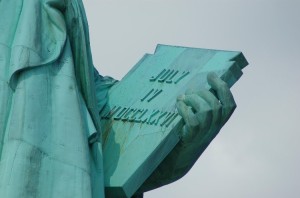
Construction of the Statue of Liberty –
By 1875, with the Centennial Exposition in Philadelphia about to open the following year, Laboulaye decided the time was right to announce the project and the Franco-American Union was formed to raise funds. France would finance and build the statue and the United States would finance and built the pedestal on which it would be placed. At this time the statue received an official name, “Liberty Enlightening the World” and the announcement generated a favorable response on both sides of the Atlantic. To call even more attention to the project, Bartholdi planned to go ahead with fabricating the statue’s right arm holding the torch to be display at the Exposition. Bartholdi consulted with his friend Eugene Viottet le Duc, an experienced architect and engineer, and it was decided that the masonry form of the statue would be covered with layers of copper panels less than an inch thick which would be applied by heating the metal and then hammering it into shape. (It has been estimated that over 200,000 pounds of copper was needed to build the completed statue)
As the date of the Exposition rapidly approached Bartholdi went to Philadelphia as a member of the French delegation and they brought a massive painting of the proposed completed statue and also the arm and torch that was barely finished in time to ship to Philadelphia. After the exhibition closed, the arm and torch were moved to New York City to be displayed for several years while committees in New York, Boston and Philadelphia organized to raise the necessary funds to build the pedestal. On March 2, 1877, on his last day in office President Grant signed a joint resolution to accept the statue from France. The next day, the new incoming President Rutherford Hayes officially selected the site as Bedloe’s Island in the New York Harbor, which had been originally proposed by Bartholdi.
After returning to Paris after the Exposition, Bartholdi oversaw the building of another portion of the figure from the head to the shoulders. Construction took place once again at the Gaget, Gauthier & Co. warehouse, tickets were sold to the public to view the work progressing and lottery tickets were also sold for prizes such as silver plated and terracotta miniature models of the completed statue to raise funds. By 1878, the head and shoulder section was completed and it went on display at the Paris World’s Fair to generate even more funds for the statue construction.
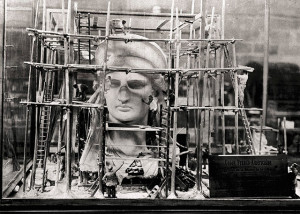
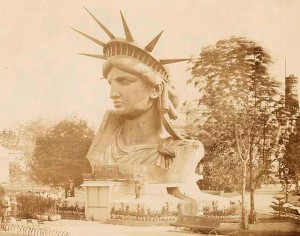
Then, in 1879, Viollet le Duc died and an innovative designer and builder named Gustave Eiffel was hired to complete the project. At this time, Eiffel decided to construct an iron truss tower instead of the previous masonry support which had been used in constructing the arm and the torch. The use of the interior iron structure would allow potential movement of the statue from the anticipated winds of the New York Harbor which could lead to possible cracking of the outer copper layer; the interior structure was attached to a center pylon for additional support with flat iron bars. To prevent later corrosion between the copper exterior layer and the interior iron support structure Eiffel solved the problem by inserting a layer of asbestos and shellac between the two layers. Within the structure, Eiffel also built two interior spiral staircases to provide access for future visitors to reach observation platforms in the crown and also the torch. This change in design would allow the entire construction of the statue to be done in France and then disassembled, transported to New York and reassembled once the pedestal was completed on Bedloe’s Island. (Sadly, Laboulaye died in 1883 and he was able to see his idea of the Statue almost fully completed in France but before it was sent to be formally presented to the United States)
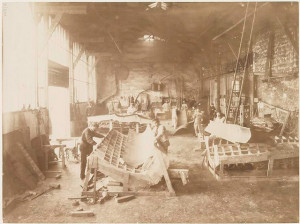
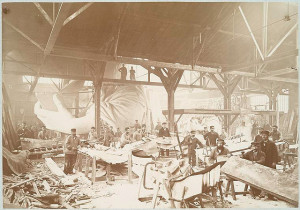
Construction of the pedestal for the Statue of Liberty –
In the following years, the United States had a difficult time coming up with the funds to build the pedestal. Despite this fact, they went forward with the project and between 1807 and 1811 the foundation for the statue was built on Bedloe’s Island inside Fort Wood. The base of the foundation which would be 15 feet deep and shaped as an eleven-point star and the pedestal would be aligned to the southeast so that the front of the statue would be facing the open Atlantic Ocean to be seen as ships entered the New York harbor. Construction on the foundation began in 1883 and the pedestal cornerstone was laid in 1884. Then, the New York committee commissioned Richard Morris Hunt to design the pedestal, it was originally proposed to be 114 feet in height but because not enough money had been raised the height was reduced to 89 feet. The pedestal design was also to be made of solid granite but, once again because of lack of funds, the finished pedestal would have concrete walls which were faced with 20 feet thick blocks of granite. The pedestal is 62 feet square at the base and almost 40 feet at the top. Each of the four sides had ten circular pieces positioned near the base of the pedestal that Bartholdi had originally proposed for the seals of the States of America, there were 38 at the time of construction, but this was not done. At the top section of the pedestal on each side there is a balcony.
Final construction phase of the Statue of Liberty (joining the statue with the pedestal) –
Despite the fact that the pedestal had not been finished, the completed Statue of Liberty had been disassembled, grated and packed for transport from France aboard the French Navy ship, “Isere”, which arrived in New York on June 17, 1885. With the arrival of the statue in the United States contributions suddenly poured in to finally allow the pedestal to be complete in April 1886. Now the reconstruction of the statue could start and the iron framework designed by Eiffel was firmly anchored to the steel beams protruding from the pedestal. Then, very carefully the slow process of attaching each section of the outer copper layers began. Bartholdi had originally planned for floodlights to be attached on the torch’s balcony but this was vetoed by the Army Corps of Engineers because it was determined that the light would be too bright for approaching ships entering the harbor. Instead, Bartholdi cut sections into the torch and placed the lights inside, then the torch was covered in gold leaf and a power plant was built on the island specifically to provide electricity for lighting the torch. Once the statue was completely re-assembled on the pedestal, it was time for the official dedication.
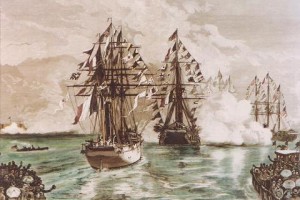
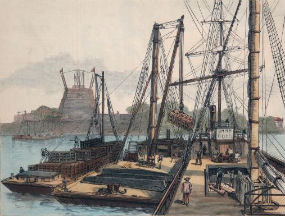
Dedication of the Statue of Liberty –
The dedication ceremony for the Statue of Liberty took place on October 28, 1886 a little over ten years after the original idea was conceived by Edouard Rene de Laboulaye. The morning of the dedication started with a parade through the streets of New York City. President Grover Cleveland presided over the parade and almost a millions people lined the streets watched the festivities. When the parade reached Wall Street and passed by the New York Stock Exchange, the traders inside the building threw ticker tape from the windows, this was the very first “ticker-tape parade” and it started a New York tradition. Then, in the afternoon President Cleveland boarded a yacht and left the docks in New York accompanied by a flotilla of other ships and boats to travel the short distance across the harbor to Bedloe’s Island for the official dedication ceremony. Several speeches were given and then the French flag draped over the statue’s face was dropped prematurely and the crowds roared. One of the final speakers at the dedication was President Cleveland who said in his speech that day; “let the stream of light pierce the darkness of ignorance and man’s oppression until Liberty enlightens the world”. Bartholdi was present that day at the dedication but he choose not to speak. Unfortunately due to bad weather, the officially lighting of the torch took place a few days later on November 1.
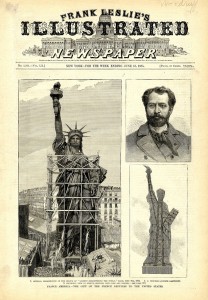
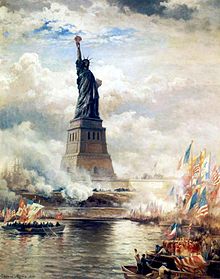
Additional information regarding the Statue of Liberty –
Over the next decade, the copper color of the Statue of Liberty changed to verdigris; this was caused by atmospheric oxidation which changes the properties of the copper metal resulting in it turning a soft blue-green color. Initially the decision was made to paint both the interior and exterior of the statue but upon further examination it was determine that the strength and integrity of the copper was not compromised. The public protested against the exorbitant cost of repainting and also felt that the new verdigris color seemed to soften the statue’s sharp lines and made it even more beautiful. The final decision was made that only the interior of the statue would be painted and the Corps of Engineers also took this time to install an elevator which would take visitors from the base to the top of the pedestal.
During World War I, an event that has become known as the Black Tom incident happened on July 30, 1916. Several containers of dynamite and other explosives that were intended for shipment to Britain to aid in their war efforts were being stored close to Bedloe’s Island. Mysteriously the containers detonated and it was later linked to German agents who were intent on stopping the ammunition from getting to their English enemies that had ignited the supply; seven people were killed in the explosion. The Statue of Liberty had over $100,000 in damages which eventually required the torch staircase to the top platform to be permanently closed. During the renovation process Gutzon Borglum, the man responsible for the building Mount Rushmore, designed a new stained glass torch which replaced the original copper one. Also, an underwater power cable brought more power from the mainland to the island for the new floodlights placed along the walls of Fort Wood. By December 2, 1916 the project was completed and President Woodrow Wilson officially pressed the switch to turn on the lights that would now beautifully illuminate the statue.
In 1924, President Calvin Coolidge declared the Statue of Liberty a National Monument under the Antiquities Act. Then, in 1933 President Franklin Roosevelt transferred the administration of the Statue to the National Park Service (NPS). A few years later, in 1937, the NPS took control of the entire Bedloe’s Island and Fort Wood was officially closed and the remaining military buildings were demolished. The NPS closed the Statue to the public from May to December 1938 to take the opportunity for more renovations. A set of new granite steps located to the rear of the Statue were constructed to create a new public entrance. The rays from the Statue’s crown were also temporarily removed for the installation of new supports to be attached to replace the old rusted ones. (Shown below in the photos are Bedloe’s Island circa 1927 and today)
During World War II, the Statue of Liberty remained open to visitors but because of the required nighttime blackouts it was not illuminated. Then, on D-Day (June 6, 1944) the lights of the Statue sent out the Morse code signals for V (victory) and on V-E Day (May 8, 1945) the Statue was once again illuminated for a few hours every night.
In 1956, Bedloe’s Island was given the official name of Liberty Island through an Act of Congress; Bartholdi had suggested the name almost a century earlier. Then, in 1965 the nearby Ellis Island was incorporated into the Statue of Liberty National Monument through a proclamation by President Lyndon Johnson and in 1972 the Immigration Museum located in the base of the Statue was opened in a ceremony attended by President Richard Nixon. (In 1991, the museum moved from Liberty Island to Ellis Island)
For the American Bicentennial, the Statue of Liberty had a more powerful lighting system installed in preparation for the festivities. It also became one of the focal points of the National during the celebration with a parade of boats in New York Harbor on July 4, 1976 and later that night there was a spectacular display of fireworks.
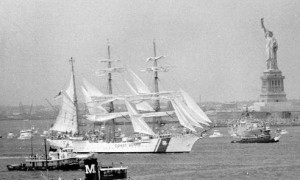
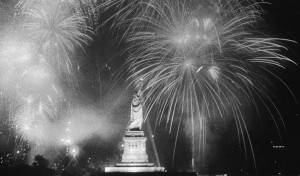
Then, in anticipation of the Statue of Liberty Centennial celebration coming up in 1986, a group of French and American engineers carefully examined both the interior and exterior structures of the Statue. The Statue was found to have severe structural problems that need extensive repairs and a massive restoration was required. An interesting fact was discovered during the inspection when it was determined that the head of the Statue had been originally installed two feet off center. In May 1982, President Ronald Reagan announced the formation of the Statue of Liberty-Ellis Island Centennial Commission Foundation which organized a variety of events and promotions to raise the $350 million dollars needed for the restoration project.
In, 1984, the Statue of Liberty was closed to the public for the duration of the restoration project and a free-standing scaffold was construction to aid in the repairs. To start the project the Statue need a thorough cleaning and liquid nitrogen was used to remove several layers of interior paint which had been done over the years to prevent corrosion. The work was difficult because of the toxic asbestos that Batholdi had originally used to provide insulation for the Statue and workers were required to wear protective gear with a breathing apparatus attached. The exterior copper layer was cleaned with baking soda solution to remove a buildup of tar that had accumulated over the years and also holes that had developed in the outer copper layers were repaired. The stained-glass torch designed by Borglum and installed in 1916 was found to be severely leaking and the decision was made to replace that torch with another one that would be an exact replica of the original Batholdi design and it would be covered with a layer 25-carat gold that today shines brightly in the daytime sun and when lighted at night. The entire iron interior support structure designed by Eiffel was replaced and reinforced with stainless steel bars. The floodlights at the base of the Statue were replaced and repositioned to highlight the various details of the Statue. The public entrance build in the 1960s was altered to have a wider opening framed by a set of massive bronze doors and a new elevator was installed to provide handicapped access to the pedestal’s observation deck.
In celebration of the Statue of Liberty’s Centennial, three days of events would take place from July 3 to 6, 1986. President Reagan presided over the rededication and the French President Francois Mitterrand was also in attendance for the festivities. In his rededication speech President Reagan said, “We are the keepers of the flame of liberty and we hold it high for the world to see”.
Then, tragically with September 11, 2001 terrorist attack on the World Trade Center, the Statue of Liberty and access to Liberty Island was immediately closed to the public. Liberty Island reopened later at the end of 2001 but the pedestal and the statue remained closed to the public. Several years later, in August 2004, the pedestal re-opened but the NPS announced that visitors access would be restricted to the Statue. Eventually, by July 4, 2009, President Barrack Obama announced that the Statue would be re-opened to the public but that there would be limited access with only a certain number of people permitted to ascend to the crown each day.
Recently, in October 2011, the Statue was once again closed for a year for the installation of new elevators and staircases. Unfortunately, just one day after the reopening on October 28, 2012, Hurricane Sandy hit the East coast and as a precaution the Statue was closed again. Although the Statue was not damaged in the hurricane, both Liberty Island and Ellis Island sustained damage to the docks used by the ferries to transport visitors to the islands. The decision was made to close both Liberty Island and Ellis Island while the repairs were being done. Finally, Liberty Island opened in time for the July 4, 2013 celebration and Ellis Island re-opened in October 2013.

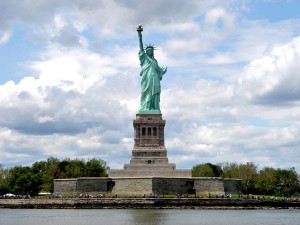
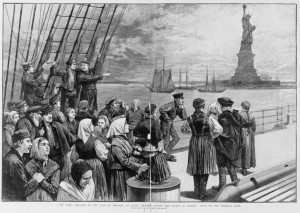
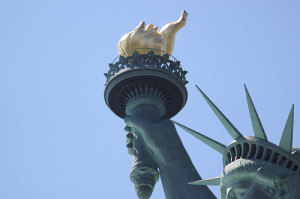
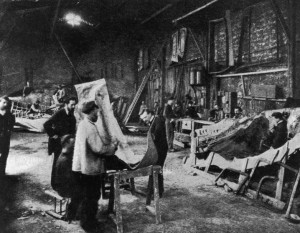
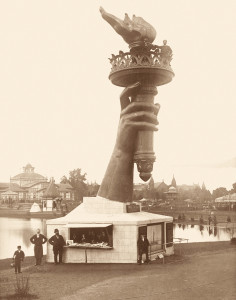
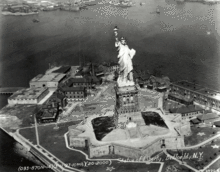
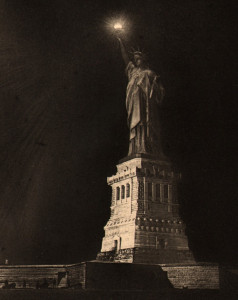
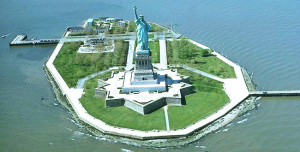
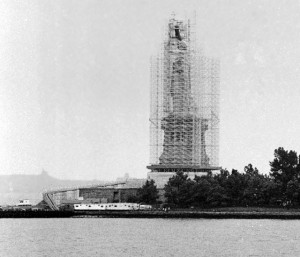
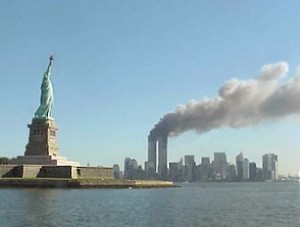
Thanks for the extensive history lesson about the Statue of Liberty! It’s probably been 30 years since I’ve visited it, and I’m hoping to go back there over the summer now that it’s been reopened with access to the crown.